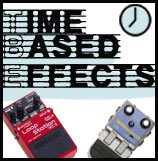Time-based distortion pedals (we’re talking flange, echo, an chorus) are less widely used as other types of distortion, but are still the best option for some of the more unique sounds that come from distortion pedals. Much of these effects are great for solos, but some practical uses that the everyday guitar player would experience exist as well. Even rhythm guitarists are cashing in on this less popular type of distortion, but there are a few things to look out for when buying them.

Figure 1 – When it comes to time based effects, don’t be surprised to see Boss pedals take the lead in most categories. (Pictured on the left)
The first type effect we will be looking at is the looping pedals. These types of pedals actually record a section of sound, with the purpose of playing them repeatedly. This is great for guitarists who don’t have a friend present to do rhythm guitar, or wants to use these loops in order to create special effects. It also lets guitarists listen to a song as whole, and not just one specific aspect. The Boss RC-2 and Digitech JamMan are good examples of pedals that will do this.
 |
 |
Figure 2– The Boss RC-2 and Digitech JamMan.
The Boss RC-2 retails at around $180 (Listen to video sample), while the Digitech JamMan retails at around $300 (Listen to video sample).
Next, we have the chorus effect. This is just as much fun as the looping effects in a sense, because there are so many sounds. A guitarist can create thick rich walls of sound (so it actually sounds like several guitars are playing at once), crazy tremolo effects, or just a light chorus to fill out a lead line slightly. Look out for the Boss CE-5, Line 6 Space Chorus, and Ibanez CF-7.
 |
 |
 |
Figure 3 – The Boss CE-5, Line 6 Space Chorus, and Ibanez CF-7.
The Boss CE-5 retails at around $80, the Line 6 Space Chorus goes for around $120, and the Ibanez CF-7 retails at about $60.
One of the more popular time delay effects is the echo. These pedals simply take incoming signal, and delay it to make a echo of the actual signal. The echo effect is amazing when added to other effects, creating amazing soundscapes – try it with a slide if you’ve got one. You can also make some very interesting rhythm effects. The most popular pedals to look out for in this category are the Boss DD-6, and the Line 6 Echo Park.
 |
 |
Figure 4 – The Boss DD-6 and the Line 6 Echo Park.
The Boss DD-6 retails at around $160 (Listen to demo), while the Line 6 Echo Park is around $150 (Listen to demo).
Lastly, we come to the interesting effect of the flanger. Several types of the flanger pedal can be doubled over as a reverb pedal as well, which is a nice benefit. The flanger essentially takes the incoming signal, slows it down, and then speeds it back up to its original position. The unique sound that results has been popular among older rock, but also sees applications in newer playing styles. Add it to distortion and you’ll sound more like a jet engine at take off. Flangers are pretty good for bass too. The leaders of the flanger industry include the Boss BF-3, and the Line 6 Liqua Flange.
 |
 |
Figure 5 – The Boss BF-3 and Line 6 Liqua-Flange.
The Boss BF-3 retails at around $120 (Listen to sample), while the Line 6 Liqua-Flange comes in at around at the same price of $120 (Liten to sample).
The majority of time based distortion pedals will be used in solos or specific rhythm applications, and to provide contrast to a basic sound. You can have real fun with some of these sounds, but take care not to overdo it! Its hard I know. Nevertheless, they provide fantastic sounds that many bands from Rock and Roll’s past have taken advantage of- and they are just as popular today.

Hey!
I just wanted to say thanks for the informative post. I bought a BOSS GT-5 quite a while back, and to be honest with you: I ended up resorting to simple distortion pedals like the ones above.
I love using pedals for effects (and especially writing with effects as inspiration), but for some reason the classics just work better with my style.
Anyway, thanks again. Take it easy,
Kyle